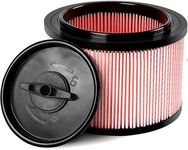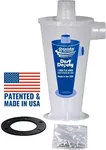Buying Guide for the Best Cyclone Dust Collectors
Cyclone dust collectors are essential tools for maintaining a clean and safe working environment, especially in workshops and industrial settings. They work by using a cyclonic action to separate dust and debris from the air, ensuring that fine particles are captured before they can cause harm or damage. When choosing a cyclone dust collector, it's important to consider several key specifications to ensure you select the right model for your needs. Understanding these specifications will help you make an informed decision and find a dust collector that effectively meets your requirements.Airflow (CFM)Airflow, measured in cubic feet per minute (CFM), indicates the volume of air the dust collector can move. This is crucial because higher airflow means more efficient dust collection. For small workshops or home use, a lower CFM (around 500-1000) might be sufficient. Medium-sized workshops may need a CFM range of 1000-1500, while larger industrial settings often require 1500 CFM or more. Consider the size of your workspace and the type of tools you use to determine the appropriate airflow for your needs.
Static Pressure (SP)Static pressure, measured in inches of water gauge (in. wg), refers to the resistance to airflow within the dust collection system. Higher static pressure indicates the system can handle more resistance, which is important if you have long ductwork or multiple machines connected. For simple setups with short duct runs, lower static pressure (around 5-7 in. wg) may be adequate. More complex systems with extensive ductwork or multiple branches will require higher static pressure (8-12 in. wg) to maintain efficient dust collection.
Filtration EfficiencyFiltration efficiency measures how well the dust collector can capture fine particles, typically expressed as a percentage or in microns. Higher efficiency means better air quality. For general woodworking, a filter that captures particles down to 1-2 microns is usually sufficient. However, if you work with materials that produce very fine dust, such as MDF or certain metals, you may need a filter that captures particles down to 0.3 microns. Consider the type of dust you generate to choose the right filtration efficiency.
Dust Bin CapacityDust bin capacity refers to the volume of dust and debris the collector can hold before it needs to be emptied. Larger capacities mean less frequent emptying, which can be more convenient for busy workshops. For small to medium workshops, a dust bin capacity of 20-30 gallons may be sufficient. Larger workshops or industrial settings might require capacities of 50 gallons or more. Think about the volume of dust you produce and how often you want to empty the bin to determine the right capacity.
Noise LevelNoise level, measured in decibels (dB), indicates how loud the dust collector will be during operation. This is important for maintaining a comfortable working environment. Lower noise levels (around 70-80 dB) are preferable for home workshops or areas where noise is a concern. Higher noise levels (above 80 dB) might be acceptable in larger, industrial settings where noise is less of an issue. Consider your tolerance for noise and the working environment to choose an appropriate noise level.
PortabilityPortability refers to how easily the dust collector can be moved around the workspace. This is important if you need to use the collector in different locations or if space is limited. Portable models typically have wheels and a compact design, making them suitable for smaller workshops or for users who need to move the unit frequently. Fixed models are larger and more powerful, ideal for dedicated workshop spaces where the collector will remain in one place. Consider your workspace layout and mobility needs to decide on the right level of portability.



















